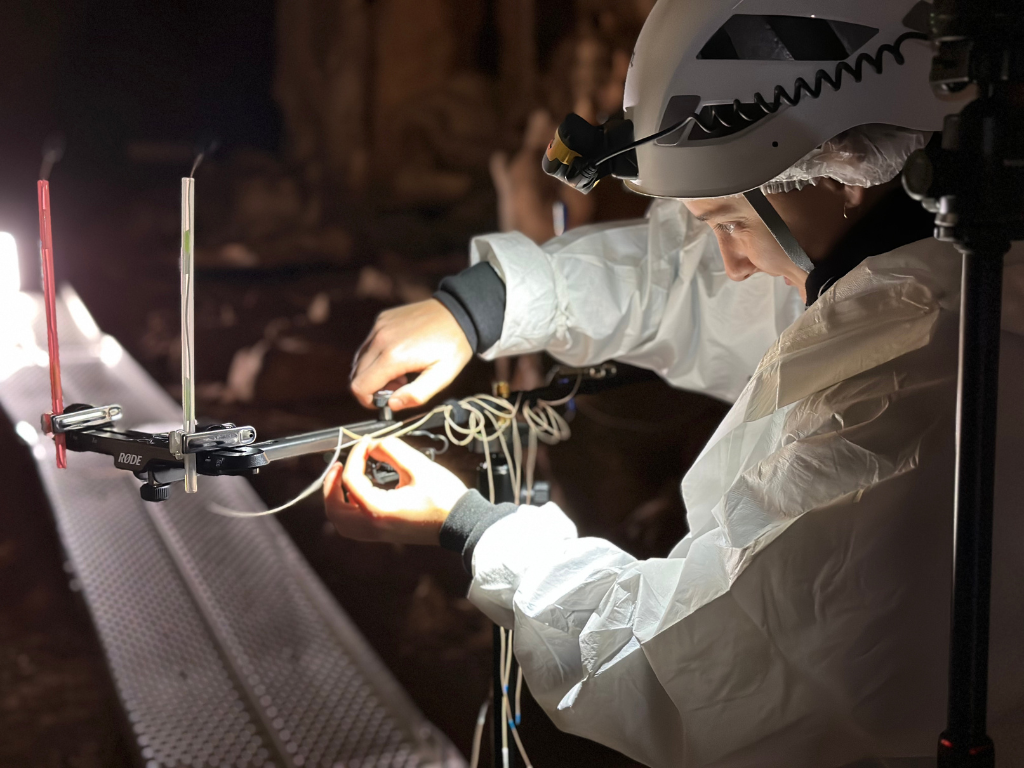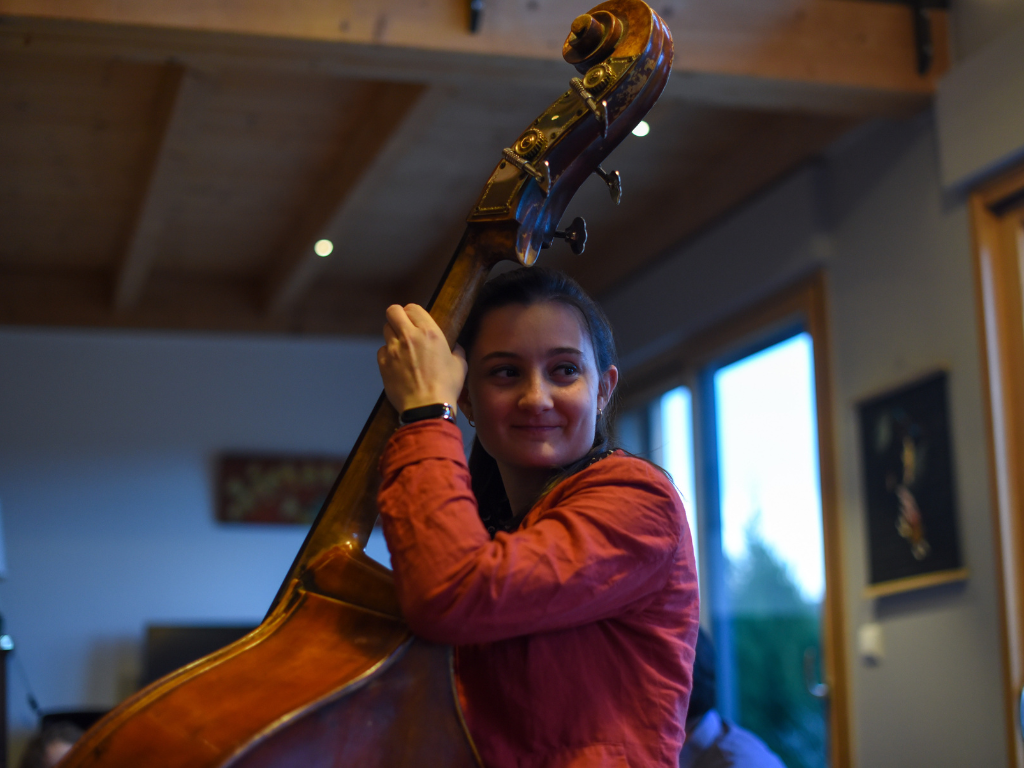
Luna Valentin is doing something — and it’s something that not everyone (almost no one) would ever think of doing.
What if I told you that she’s in a field of study called archaeoacoustics that looks at how sound affects people’s experiences in different places, from natural caves to ancient temples and sacred buildings?
Yep, this PhD in Archaeoacoustics candidate at the University of Stanford is doing just that.
Here’s how it works.

Valentin combined her love for spelunking (exploring caves) and music and pursued a PhD in Archaeoacoustics. Source: Luna Valentin
Archaeoacoustics: What does the ancient world sound like?
Well, that’s the question that Valentin’s PhD in Archaeoacoustics is trying to answer — a research that sits somewhere between archaeology, physics, and music theory.
Her focus is on caves — the first sacred spaces, long before humans began building temples or cathedrals.
“Once we started building architectural sites for rituals, we were already thinking about how it was going to sound,” Valentin says.
But before walls were built or stones were stacked, humans gathered in natural places that helped amplify sounds or chants. It would turn simple chants into something grander, more profound.
Caves, she notes, “are resonant and have very variable acoustic properties”. They hum, echo, and respond — and those acoustic notes may have shaped early rituals and even the emotional roots of music itself.
To answer her question, Valentin brings together physics and art. Deep in a cave, she sets up speakers and microphones, plays mathematically defined test signals, and records how the cave “sings back”.
As she puts it, “The signal I recorded is the original signal and the sound signature of the cave that’s created by the sound waves bouncing and propagating off the geometry of it [the cave].”
Then, Valentin observes the story written in those echoes.
“I process the signatures and it gives me information,” she says. “Metrics that tell about the reverberation time, how long sounds persist, and about intelligibility. For example, how you clap your hands in a train station or parking lot, you’re going to hear a sound that persists — that’s what we call reverberation.”
Just like modern architecture, where an office is designed to sound clear, and a cathedral is designed to sound holy, ancient people might have chosen their sacred spaces for how they sounded.
Of course, not every site is still around today.. Caves or ancient sites collapse, erode, and transform.
That’s where Valentin’s computing and archaeological background comes in.
She uses modelling and simulation to reconstruct what those ancient spaces might have looked and sounded like.
“With archaeology, the thing is, you don’t always have access to the place as it used to be,” she explains. “So we take measurements, we estimate the geometry and material, and then we try and simulate how sound waves propagate.”
In other words, Valentin listens to history, not through artefacts but through resonance. Her PhD in Archaeoacoustics reminds us that sound has always been a part of how humans connect to place, ritual, and meaning.

Valentin pursued a BS in Engineering Sciences at Lycée Léonard de Vinci. She later completed two Master’s in Musicology Research at the Université Jean Monnet Saint-Etienne. Source: Luna Valentin
But what’s so important about acoustics in caves? And how does it relate to cave paintings?
Here’s a question for you. Have you ever thought about why there are ancient paintings in caves?
French archaeoacustics researchers, Iégor Reznikoff and Michel Dauvois, have hypothesised that humans of the past were painting in places that hold a sense of high resonance; however, in the 80s, their methods were very empirical.
“They were going to these places and then singing and rolling like bears, to observe the kind of correlation between resonance and everything else that came with it,” Valetin explains. “But today, we’re trying to replicate this experiment, but with physics and mathematics. We even take measurements to build maps.”
Now, the next question that Valentin is trying to answer is, “Are we going to see the correlation between resonance or a certain type of acoustics with the places where people painted?”

Valentin has participated in six publications as part of her PhD at Stanford University. Source: Luna Valentin
A cave is large, no doubt, and there are many walls to paint on, but the hypothesis is that when conducting a ritual or painting walls, they focus on places with a specific type of acoustics.
Now, why is it so important? Well, it’s a way of expanding how we understand the past.
“On the archaeological side of things, we’ve always been very focused on what we can see — the material remains we can unearth, the architecture we can map.”
But that focus, she says, leaves out something crucial: the sensory experience of being there.
Sight has long dominated how we interpret power and meaning in ancient sites. Think of a castle perched high on a hill, as it showcases a symbol of strength and control.
Sound, however, is also a part of it.
The way a chant carries through a cave, or how a drumbeat echoes down a stone passage, would have shaped how people felt and behaved in those spaces.
And in prehistoric times, sound may have mattered even more.

Other than spelunking, Valentin plays the double bass. Source: Luna Valentin
“People then weren’t surrounded by as much noise as we are today,” Valetin says. “They were hunter-gatherers who relied on their hearing skills to survive. So sound probably had a bigger importance as it was how they experienced the world.”
Her work, in a sense, helps restore a lost dimension of human history — bringing back a sense of hearing to a field that’s mostly been about seeing.
But her research doesn’t only enrich archaeology or music theory; it also pushes the boundaries of physics.
“Today, room acoustics is mostly predictive, “ Valentin explains. “We use this side of physics to predict how a building is going to sound. But we do very little work on how spaces used to sound, and what tells us about human behaviour.”
By combining archaeology insight with acoustic simulation, she’s helping both disciplines grow.
“If we learn about behaviour through measurement,” Valentin says. “We’ll also be able to predict more and understand how humans adapt and reach sound environments.”







